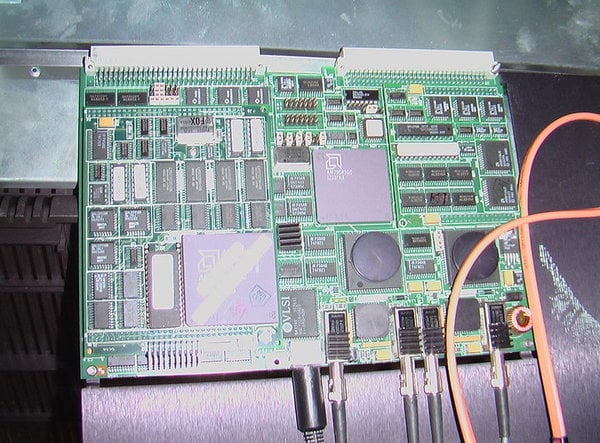SAQ wrote: That and there appear to be two or three IO4s, which would again be difficult in a deskside Onyx.
ebay onyx wrote: Includes:
* 030-0683-004 - Raster Manager w/16MB Texture Memory for IR graphics
* 030-0681-003 - Geometry Engine for IR graphics
* 030-0686-004 - PCA DG4-2
* 030-0527-508 - SCIP SCSI Mez board w/cables and connector plates
* 030-0753-005 - PCA SAMZ
* 030-0500-206 - PCA VCAM
* 030-0815-002 - PCA IO4 W/F2 AND F3
* 030-0604-106 - MC3 Board
* 030-0604-106 - MC3 Memory Board (32 SIMM slots - suports 16 & 64MB SIMMs)
* 030-8109-006 - Silicon Graphics - CALL AUDIO BOARD FOR INDIGO2
* 003-0290-003 - Scsi 50pin Controller
(ok, I shuffled the order)
I count one (IR capable) IO4, a VCAM, and two MEZs: a SAMZ (audio/serial) and an SCIP. Seems legit to me?
I always wondered why the audio connector box of Onyx1 ASO sticks out of the bulkhead. Could it be the audio daughtercard of an Indigo2 is hiding in there?
Oh, and there are VFE bulkheads, but if you look closely, it says something about the board being someones property. It appears to be gone.
Now this is a deep dark secret, so everybody keep it quiet

It turns out that when reset, the WD33C93 defaults to a SCSI ID of 0, and it was simpler to leave it that way... -- Dave Olson, in comp.sys.sgi
Currently in commercial service:
 (2x)
(2x)

In the museum : almost every MIPS/IRIX system.
Wanted : GM1 board for Professional Series GT graphics (030-0076-003, 030-0076-004)

It turns out that when reset, the WD33C93 defaults to a SCSI ID of 0, and it was simpler to leave it that way... -- Dave Olson, in comp.sys.sgi
Currently in commercial service:

 (2x)
(2x)

In the museum : almost every MIPS/IRIX system.
Wanted : GM1 board for Professional Series GT graphics (030-0076-003, 030-0076-004)

















